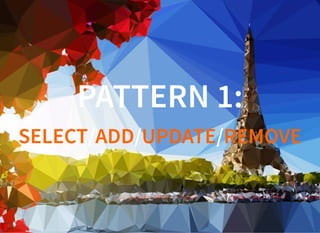D3.js is a JavaScript library for data manipulation and visualization using HTML, SVG, and CSS, emphasizing web standards for flexibility and compatibility. The document covers fundamental patterns such as data binding, path generators, interactivity, and working with layouts for creating dynamic visualizations. Key concepts include selecting and updating DOM elements with data, utilizing generators for complex shapes, and applying scales and transitions for enhanced visual effects.














![More information contact me: @josdirksen / jos.dirksen@gmail.com / www.smartjava.org / github.com/josdirksen
STEP 0: THE DATA WE'RE WORKING WITH
Data is a just an array: []
We'll use sample data:
1 to 10 elements
each element random value 20 to 40
Handled in this example by getRandomData()
val data = [26.23690455102537, 25.132792981537815,
34.363197598539266]](https://image.slidesharecdn.com/slides-171110074253/85/D3-Easy-and-flexible-data-visualisation-using-web-standards-15-320.jpg)




![More information contact me: @josdirksen / jos.dirksen@gmail.com / www.smartjava.org / github.com/josdirksen
DATABINDING ON INDEX
With data we can provide an accessor function.
Data is now bound and updated on d.id
E.g useful for sorting and moving elements
var input = [
{id: 3, value: 22.63978478623312}
{id: 6, value: 23.562434755740533}
{id: 8, value: 23.82717533064451}];
var circles = chart.selectAll('circle').data(input
, function(d) {return d.id});](https://image.slidesharecdn.com/slides-171110074253/85/D3-Easy-and-flexible-data-visualisation-using-web-standards-20-320.jpg)






![More information contact me: @josdirksen / jos.dirksen@gmail.com / www.smartjava.org / github.com/josdirksen
COMBINED WITH THE PIE FUNCTION
d3.pie() to generate config for d3.arc
var arc = d3.arc()
.outerRadius(height/2 * 0.6).innerRadius(height/2 * 0.3);
var data = [{count:10}, {count:20}, {count:30}]
var pie = d3.pie().padAngle(0.04)
.value(function (d) { return d.count; });
var arcs = pie(data)
// "[{"data":{"count":10},"index":2,"value":10,
// "startAngle":5.215987755982988,
// "endAngle":6.283185307179586,"padAngle":0.04},
// {"data":{"count":20},"index":1,"value":20,
// "startAngle":3.121592653589793,
// "endAngle":5.215987755982988,"padAngle":0.04} ...
selectAll("path").data(arcs).enter()
.append("path").attr("d", arc);](https://image.slidesharecdn.com/slides-171110074253/85/D3-Easy-and-flexible-data-visualisation-using-web-standards-27-320.jpg)



![More information contact me: @josdirksen / jos.dirksen@gmail.com / www.smartjava.org / github.com/josdirksen
SPIRAL CODE: SETUP 1/2
var minR = 20;
var maxR = height/2;
// determine min and max values to determine range
var minValue = years.reduce ....
var maxValue = years.reduce ....
// set the scale for the radius
var radius = d3.scaleLinear().range([minR, maxR]).domain([minValue, maxValue+0.3]);
var color = d3.scaleSequential(d3.interpolateRainbow).domain([0, years.length]);
// configure the path generator
var radialGenerator = d3.lineRadial();
radialGenerator.radius(function(d) { return radius(d.value); });
radialGenerator.angle(function(d) { return ((2*Math.PI)/12) * d.monthIndex; });](https://image.slidesharecdn.com/slides-171110074253/85/D3-Easy-and-flexible-data-visualisation-using-web-standards-31-320.jpg)
![More information contact me: @josdirksen / jos.dirksen@gmail.com / www.smartjava.org / github.com/josdirksen
SPIRAL: RENDER LOOP 2/2
function appendYear() {
// select and bind the data
var dataToShow = years.slice(0, year);
var current = graph.selectAll("path").data(dataToShow);
// We only add new data, we don't update existing data.
current.enter()
.append("path")
.attr("d", function(d,i) { return radialGenerator(d.months)})
.attr("stroke", function(d,i) { return color(i)});
graph.select(".currentYear").text(dataToShow[dataToShow.length-1].year);
year++;
}](https://image.slidesharecdn.com/slides-171110074253/85/D3-Easy-and-flexible-data-visualisation-using-web-standards-32-320.jpg)


![More information contact me: @josdirksen / jos.dirksen@gmail.com / www.smartjava.org / github.com/josdirksen
SCALELINEAR: CONTINUOUS INPUT TO
CONTINUOUS OUTPUT
var x = d3.scaleLinear()
.domain([10, 130]) // e.g the min and max of your data
.range([0, 960]); // the width of your chart
x(20); // 80
x(50); // 320
var color = d3.scaleLinear()
.domain([10, 100])
.range(["brown", "steelblue"]);
color(20); // "#9a3439"
color(50); // "#7b5167"](https://image.slidesharecdn.com/slides-171110074253/85/D3-Easy-and-flexible-data-visualisation-using-web-standards-35-320.jpg)

















![More information contact me: @josdirksen / jos.dirksen@gmail.com / www.smartjava.org / github.com/josdirksen
STEP 3: CONVERT TO HIERARCHY
// use our nested data, and tell d3 that the
// children can be accessed through the values property
var root = d3.hierarchy(source, function(d){return d.values;})
// Count the populations to create the hierarchy
.sum(function(data) { return data['Population']; })
// sort the hierarchy based on value
.sort(function(a, b) { return b.value - a.value; });](https://image.slidesharecdn.com/slides-171110074253/85/D3-Easy-and-flexible-data-visualisation-using-web-standards-53-320.jpg)
![More information contact me: @josdirksen / jos.dirksen@gmail.com / www.smartjava.org / github.com/josdirksen
STEP 4: ENHANCE WITH THE TREEMAP
LAYOUT
var tree = d3.treemap().size([width, height]).padding(2)
tree(root);](https://image.slidesharecdn.com/slides-171110074253/85/D3-Easy-and-flexible-data-visualisation-using-web-standards-54-320.jpg)














![More information contact me: @josdirksen / jos.dirksen@gmail.com / www.smartjava.org / github.com/josdirksen
GEOJSON AND TOPOJSON FORMATS
Can contain multiple geometries.
Each geometry is described (usually) as a path.
Can contain additional properties
population, unemployment rate, etc.
one file for everything
Try to work with TopoJSON, since it's much smaller
{"type":"Topology","objects":{"countries":{"type":"GeometryCollection",
"geometries":[{"type":"Polygon","id":"004","arcs":[[0,1,2,3,4,5]],
"properties":{"value":"7","countryA":"AFG","name":"Afghanistan"}},
{"type":"MultiPolygon","id":"024","arcs":[[[6,7,8,9]],[[10,11,12]]],
"properties":{"value":"10.2"....](https://image.slidesharecdn.com/slides-171110074253/85/D3-Easy-and-flexible-data-visualisation-using-web-standards-69-320.jpg)





![More information contact me: @josdirksen / jos.dirksen@gmail.com / www.smartjava.org / github.com/josdirksen
ADD A SIMPLE SCALE
var color = d3.scaleSequential(d3.interpolateGreens).domain([0,100])
var projection = d3.geoNaturalEarth()
var path = d3.geoPath().projection(projection)
d3.json("./data/world-110m-inet.json", function(loadedTopo) {
countries = topojson.feature(loadedTopo,
loadedTopo.objects.countries).features;
svg.selectAll('.country').data(countries).enter()
.append("path")
.classed('country', true)
.attr("d", path);
.attr("fill", function(d) {return d.properties.value
? color(+d.properties.value)
: '#ccc'});
}](https://image.slidesharecdn.com/slides-171110074253/85/D3-Easy-and-flexible-data-visualisation-using-web-standards-75-320.jpg)








